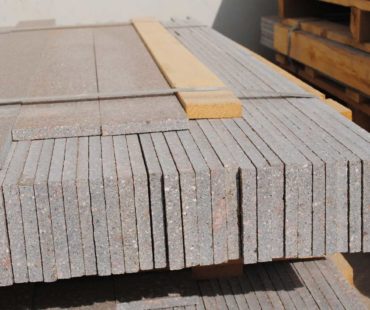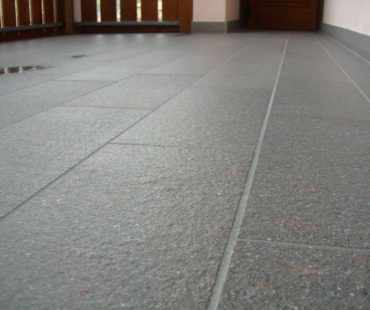Flags with sawn edges and flamed surface
This material has sawn edges and a flamed surface.
Flamed porphyry is a variant of volcanic rock that is highly valued in construction and urban planning. The special art of porphyry is obtained through a heat treatment process known as “flaming”.
Flaming involves exposing the surface of the stone to high temperatures using an oxyhydrogen flame, which melts out the mineral crystals present in the rock. This treatment gives the porphyry a rough, non-slip surface, making it ideal for outdoor flooring and sidewalk areas with high traffic.

Due to its resistance and durability, flamed porphyry is particularly suitable for projects where the material is exposed to adverse climatic conditions and mechanical wear. The irregular surface not only improves slip resistance, but also provides a unique appearance that highlights the natural properties of the stone. The flamed porphyry floor tiles are available in various sizes and colors, resulting in a wide variety of designs.
Flamed porphyry is a robust and tasteful solution for a wide range of architectural uses. With proper care, it manages to maintain its technical and aesthetic properties over time, making it a good investment for those looking for a quality and long-lasting building material.
Main characteristics of flamed porphyry
Flamed porphyry is a natural stone variant that is particularly appreciated for its resistance and durability. The main characteristic of the material is its surface, which is obtained by heating, known as “flaming”. This process involves exposing the stone surface to a high-temperature flame, which causes a rapid and irregular melting of the mineral crystals present in the porphyry. The result is a rough and non-slip surface, ideal for outdoor paving such as flooring, steps and wall cladding.
From an optical point of view, flamed porphyry is characterized by its diverse shades, ranging from red to gray, brown and purple. This variety of colors makes it a versatile option for all types of architectural projects. Flamed porphyry tiles are often used in urban and residential areas due to their ability to blend harmoniously into the surroundings.
Another important feature of flamed porphyry, in addition to the aesthetic aspect, is its high resistance to weathering and mechanical wear. This makes it particularly suitable for areas with high pedestrian or vehicle traffic.
In summary, the main characteristics of flamed porphyry – strength, durability, his aesthetics and sustainability – make it an excellent choice for a wide range of use. Its anti-slip property and ability to retain its unique appearance over time make it an ideal solution for everyone looking for a durable and elegant material.

Primarily use of flamed porphyry
Flamed porphyry is a mainly choice for a variety of projects due to it’s robustness and distinctive appearance. Because of it‘s resistance to weathering and wear, it is often used for laying in urban areas such as squares, sidewalks and courtyards. Flamed porphyry tiles are particularly appreciated for their non-slip surface, which makes them ideal for use in pedestrian areas and places with high humidity such as swimming pools and gardens or parks. In the private residential sector, flamed porphyry is used to create ways, terraces and external stairs, giving outdoor spaces a touch of rustic elegance.
His ability to maintain the naturalness while being extremely robust also makes it an excellent choice for external wall cladding. Flamed porphyry is often laid in public areas, such as in an old town or urban sidewalk areas, where aesthetics and durability are required. The versatility of the material also allows the creation of decorative elements such as fountains, frames and pillars.
Thanks to its hardness and resistance to weathering, flamed porphyry is suitable for projects that require a long life without compromising on appearance. The combination of functionality and beauty makes this material a frequent choice not only among architects and designers, but also for homeowners who want to enhance their outdoor space in a long-lasting and elegant way.
How to care and treat flamed porphyry
Flamed porphyry is known for its resistance and beauty. Regular care will preserve these properties for a long time. To ensure that, it is important to follow a few simple cleaning and maintenance practices. First of all, regular cleaning with water and a neutral detergent will be enough. Don’t use aggressive chemical products, as these can damage the surface. A soft brush is enough to remove stubborn dirt without scratching the material. To further protect the flamed porphyry against stains and environmental influences, it is recommended to apply a special natural stone treatment.
The frequency of application of the product depends on the wear and tear of the porphyry. In general, it is recommended to renew the treatment every 1-2 years. In the case of particularly stubborn stains or superficial damage, targeted repair by flaming or brushing should be used. These interventions can restore the original appearance of the porphyry without affecting its natural properties. It is recommended to check the joints regularly and to take immediate action if there is any damage. This will prevent water from penetrating. If you follow these simple instructions, the flamed porphyry will retain its appearance and functional properties for years. It will reward you with an elegant and practical surface for indoors and outdoors.





